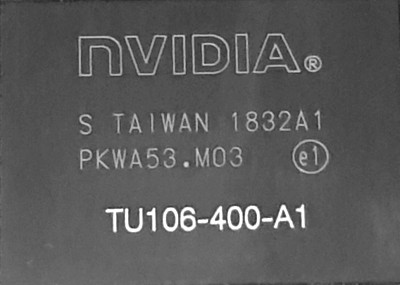Result and search for traces
There is a result that we can register immediately after the first power-on. The LED-Geraffel is still doing what it is supposed to do. Otherwise, however, the card remains quiet, far too quiet. This clearly proves to us that even two supposedly similar boards, each equipped with a non-A and an A-chip, cannot be flashed in shape by a simple BIOS ping pong in any direction, by the way. And that is precisely why we can now draw certain conclusions from this.
I have also long sat comparing both firmware packages binary, also with other extracts from BIOSes of these two chip classes. For the reasons given in this article, I will not leave myself to say which areas the OEM can use for individual adaptation (e.g. specifications for fan curves, own functions, etc.) and where you might suspect Nvidia's backed data. It is of no use, because for the evaluation of the latter one would also have to know the algorithms of protection used.
There is also a physical hardware ID
Although the chips come from the same wafers, you will find a different hardware ID. The same applies to the Quadro cards, which are also based on identical hardware. As far as our information is correct, Nvidia solves this specification in A-, S- or even Quadro by means of a so-called "hardware strap", i.e. a small additional component on the BGA board, not by an identifier on or in the Die. We are looking for it, don't be afraid.
But that would have been too easy in the end. This is precisely why a GeForce RTX 2070 cannot be flashed to a Quadro-RTX 4000, even if it should actually be feasible in terms of functionality. Too bad for the more savvy game matz, good for Nvidia's postoffice.
Two different packages and labels
Let's look at the top of both chips! On the left the "good" A-chip from calendar week 28 of this year, on the right the "bad" and significantly younger chip from KW 32. We also see that labeling and engraving differ a little. Instead of the "A" to the left of the Taiwan, you can see an "S" (Salvage?) at the cheaper chip. Also the font and the character spacing are not the same. The chip code as TU106-400-A1 was also printed retrospectively and separately.


One could almost think that here two very different providers or systems were used for IC Packaging and that this "S" chip must have been labelled for use only later and especially afterwards. Whether this happened, because one was impure with the price and wanted to push something more suitable, one can only guess at this point.
The Flash as such works perfectly
The (re-)programming of EEPROMs has never been easier than with this Chinese hardware from the Asia discounter shelf. Even if you have approx. 18 Euro at Prime to get this hardware on the table within two days stress-free, it is more than cheap! Because the scope is larger than you think.
A recent test with a completely "bricked" motherboard, where the deletion of the EEPROM was only performed incorrectly due to an error in the flash software and then also a re-description also failed, shows that something like this can be done with a could be easily repaired by external programmers. This means that such an acquisition is not a luxury commodity. In addition, I think that re-flashing by means of an external tool is much safer and even easier in the end.
Conclusion
Nvidia is not Mother Theresa, that much has already been said. And since it is probably not primarily a matter of protecting the buyer from himself, Nvidia of course protects itself first. This is done in front of certain board partners, who should not be tempted to do something ill-considered and exchange it purely "randomly" cheaply with expensive. One thing we immediately noticed when turning on the re-flashed card: Nvidia put forward a thick, fat bar there.
Yes, you can flash and yes, there was no damage, because you can write everything back. But you can't just force both cards. Of course, this does not stop the sensation, but it also shows very nicely how high Nvidia has hung the latte by now.
But what we can take with us is a very practical guide, which also shows how easy it is to save a supposedly completely "bricked" card if the software tools fail. And it even works for other things like Motherboards. By the way, it doesn't matter whether AMD or Nvidia with the EEPROM direct flash, because before the programmer everyone is the same, even Lisa and Jensen. Also a realization.

































Kommentieren